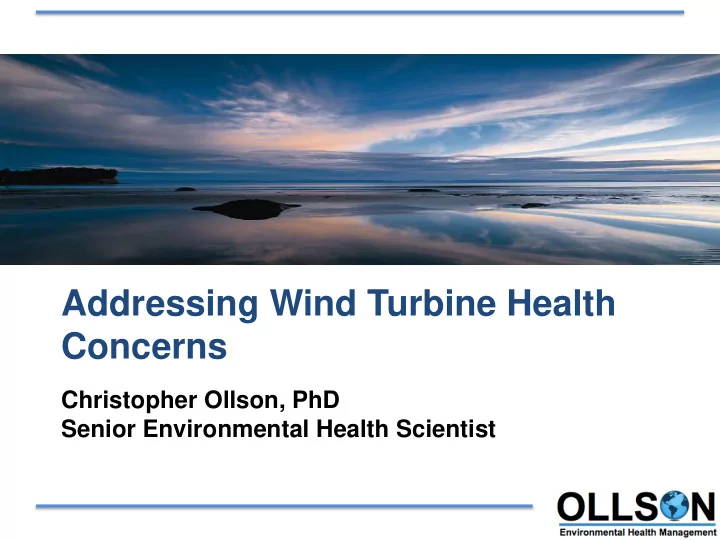

Addressing Wind Turbine Health Concerns Christopher Ollson, PhD Senior Environmental Health Scientist
Guiding Principles of the PSD Proposed Sound Rule • PSL of 45 dBA at the exterior of homes. • These permissible sound levels may be waived through sound easement, waiver, or property buyout agreement. • No interior sound standard for residences or occupied dwellings is proposed • Proposed projects will be required to use a sound model acceptable to the PSB to determine predicted levels at the outside of residences or occupied dwellings. • The PSD is recommending that post-construction monitoring so projects will have to demonstrate that they are in compliance with the sound rule PSL. • That a process will be proposed by the PSD for resolving any complaints with regards to sound levels at a residence or occupied dwelling after operations commence.
Wind Turbine Health Concerns – The Weight of Scientific Evidence • Based on the findings and scientific merit of the over 75 available peer-reviewed scientific studies, the weight of evidence is that when sited properly (sound and distance), properly sited wind turbines do not cause adverse health effects. • This includes concerns around: – Audible Noise (sound you hear) – Low Frequency Noise – Infrasound – Self-Reported and Objective Measures of Health Impact – Annoyance – Quality of Life
2014 Largest study ever undertaken around the world. The following were not found to be associated with wind turbine noise: a. self-reported sleep (e.g., general disturbance, use of sleep medication, diagnosed sleep disorders) and physical measures of sleep; b. self-reported illnesses (e.g., dizziness, tinnitus, prevalence of frequent migraines and headaches) and chronic health conditions (e.g., heart disease, high blood pressure and diabetes); and c. self-reported perceived stress and quality of life. The overall conclusion to emerge from the study findings is that the study found no evidence of an association between exposure to WTN and the prevalence of self-reported or measured health effects beyond annoyance.
SLEEP
Conclusions: Study results do not support an association between exposure to outdoor WTN up to 46 dB(A) and an increase in the prevalence of disturbed sleep.
Sound Levels up to 54 dBA
LOW FREQUENCY NOISE AND INFRASOUND
What about Low Frequency Noise / Infrasound? • Are Low Frequency Noise and Infrasound emitted from wind turbines? – YES • Are they emitted at levels that pose a potential health concern? – NO • Are audible sound limits (dBA) for wind turbines sufficient to protect for emitted Low Frequency Noise and Infrasound from wind turbines? – YES
Infrasound Infrasound LFN Infrasound and Low Guideline Frequency Noise Wind Turbines and Other Sources
Low Frequency Noise / Infrasound Over-all, the available data from this and other studies suggest that health-based audible noise wind turbine siting guidelines provide an effective means to evaluate, monitor, and protect potential receptors from audible noise as well as Infrasound and Low Frequency Noise.
Potential Health Concerns
Beyond annoyance, results do not support an association between exposure to WTN up to 46 dBA and the evaluated health-related endpoints.
Annoyance
“Variables associated with WTN annoyance included, but were not limited to, other wind turbine-related annoyances, personal benefit, noise sensitivity, physical safety concerns, property ownership, and province.” Only 9% of the annoyance could be explained by WTN.
Supporting Government Studies • Chatham Kent Public Health Unit of Chatham Ontario. 2008. The Health Impact of Wind Turbines: A Review of the Current White, Grey, and Published Literature • National Health and Medical Research Council in Australia. 2010. Wind Turbines and Health: A Rapid Review of the Evidence . Canberra, ACT: Commonwealth of Australia p. 1 – 11. • Chief Medical Officer of Health Ontario. 2010. The Potential Health Impact of Wind Turbines . Chief Medical Officer of Health (CMOH) report. Toronto, ON: Queen’s Printer for Ontario. p. 1 – 14. • Massachusetts Department of Environmental Protection and Department of Public Health. 2012. Wind Turbine Health Impact Study: Report on Independent Expert Panel . Department of Environmental Protection and Department of Public Health • Oregon Health Authority. 2013. Strategic Health Impact Assessment on Wind Energy Development in Oregon. • Merlin T, Newton S, Ellery B, Milverton J, Farah C. 2014. Systematic Review of the Human Health Effects of Wind Farms . Canberra, ACT: Australia National Health and Medical Research Council • Wisconsin Wind Siting Council. 2014. Wind Turbine Siting-Health Review and Wind Siting Policy Update • Canadian Council of Academies 2015. “ Understanding the evidence: Wind turbine noise - The Expert Panel on Wind Turbine Noise and Human Health ”.
Conclusion • There has been considerable research conducted around the world on the potential for wind turbines to adversely impact health. Based on: – the collective findings of over 75 peer-reviewed scientific articles; – the weight of scientific evidence of health studies of those living in proximity to wind projects; and, – government agency reports reviewing this topic from around the world. • OEHM believes that the existing standard of 45 dBA is protective of public health, and that PSB will be able to propose a sound rule that is sufficient to protect the public health and welfare of Vermonters in its final rule effort.
Christopher Ollson, PhD Ollson Environmental Health Management Ancaster, Ontario, Canada christopher.ollson@gmail.com
Recommend
More recommend